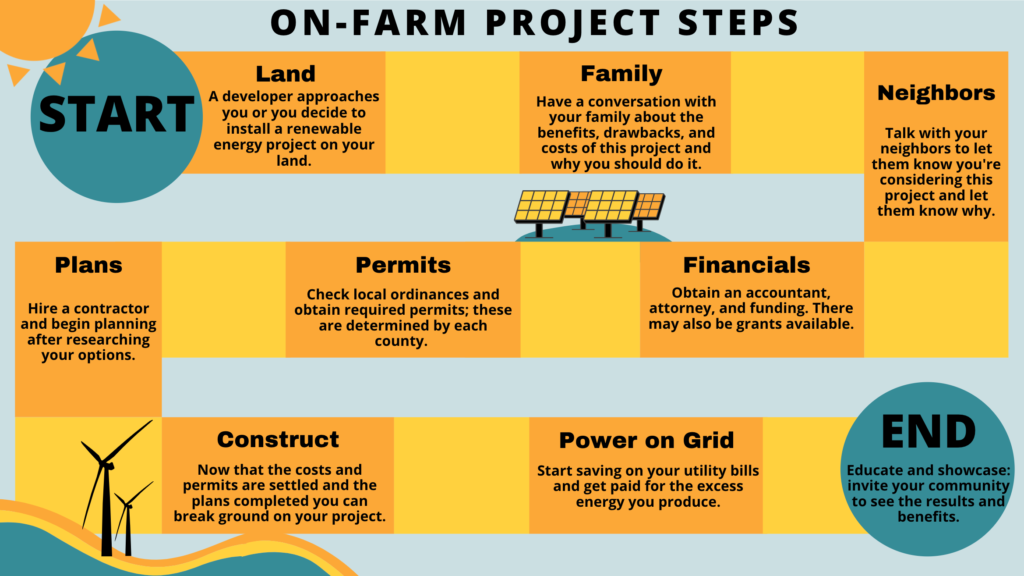Know Before You Build: On-Farm Renewable Energy Projects
Landowner-based, non-commercial

Step 1: Landowner
Begin by deciding the best spot to install the renewable energy project. Consider how and where the energy will be used and the flow of your operational activities and structures around it. For example, solar panels can be placed on rooftops, on unused cropland, or in a brownfield area.
Step 2: Hire a Contractor
Hiring a reputable contractor is an important step in setting up renewable energy projects. The contractor will give advice on the project size, cost, return on investment, and more. A knowledgeable contractor may also direct you to apply for grants/subsidies that can offset the costs of equipment and installation. The contractor will also engage the energy provider to see what options would be available and what financial opportunities they offer. It’s also advisable to find a contractor comfortable with and knowledgeable about the ordinance and permitting requirements of your county. Ordinances are local guidelines about how and where the project can be built. These vary greatly; some counties have very limited or no restrictions and in others, it is not possible to build new renewable projects such as solar. Your contractor should be able to navigate the local ordinances and explain them to you.
Step 3: Hire an Accountant and Attorney
Once the costs and return on investment of the project have been researched, it’s time to involve other professional counsel such as an accountant and attorney. Renewable energy projects can have large startup costs so it is important to discuss all funding avenues like subsidies and grants. Working with both of these advisors in concert enables you to create a viable financial and legal plan for the project.
Step 4: Ordinances and Permitting
The next step in the process is to look at renewable energy ordinances in your county. Ordinances describe the guidelines and legal framework under which the project has to comply. Some guidelines include ambient noise levels, setbacks from residential or city property, and height limits. In Indiana, ordinances vary from county to county—they can be very strict, non-existent, or anywhere in between. Generally, ordinances for landowners are usually much more relaxed than those for utility-scale projects. Again, work with your contractor to ensure the project complies with local ordinances. Permits, granted by the county commissioner’s office, will also be required. There are commonly two (2) major types of permits:
Special Exception Permits
Special Exception Permits pertain to land siting restrictions and issuance requires approval from the county’s board of zoning appeals (BZA)
Permitted Use Permits
Permitted Use Permits are given with proof that the project complies with all ordinance standards but will require a hearing at an advisory planning commission (APC) meeting. Contractors typically handle these hearings, landowners are not required to be present but it can be beneficial for you to attend. If the landowner speaks as to why they want to get this project approved it can give a positive push to the decision process. If the landowner is unable to go, they can share a letter to read during the hearing.
Step 5: Required Plans
The plans required for large projects can be extensive and variable depending on what the county ordinance requires. The most commonly required plans are environmental assessments, road use plans, drainage plans, and a decommissioning agreement. Landowner-based projects typically only have to worry about environmental assessments and decommissioning agreements.
Environmental assessments describe the impacts that the project could have on the environment including the construction of the project, species displacement, and vegetation impacts. This assessment can include a plan for enhancing vegetation growth and repopulation of pollinators after construction.
Decommissioning agreements discuss what happens at the end of the project’s life. There is some room for negotiations on these, but they are mostly dictated by the county’s ordinance. The landowner and contractor should refer to the ordinances to see what is required.
Step 6: Construct the Project
After all the plans have been made and all appropriate building permits have been received, project construction can begin. At this point, it is still important to make sure all protocols and ordinance requirements are followed. Many landowners find staying engaged in this process is both educational and interesting as they see the construction unfold.
Step 7: Educate and Showcase
Friends, family, and neighbors will be both curious and potentially concerned about seeing a new renewable energy project going up. It’s best to begin a dialog with these stakeholders as early as possible. It’s also recommended that once your project is completed that you consider Inviting the broader community to see your project. You may want to provide details on your website or social media page or consider hosting a field day where you can share your story and help others increase their understanding of renewable energy. Many farmers and landowners also opt to partner for an event with the state associations, departments of agriculture, and their developers and contractors.
